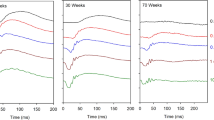Abstract
Docosahexaenoic acid (DHA), an n-3 polyunsaturated fatty acid, is found in consistently high concentrations in the retinae of mammals, yet its role in vision remains unclear. In this study, a mammalian model of variable retinal DHA concentration has been developed, such that the retinal phospholipids of guinea pigs contained between 2.5 and 30.8% DHA. Visual function was assessed using full-field flash electroretinography, over a range of exposure levels spanning six log units. Trend analysis indicated that retinal function was altered by the tissue DHA level, and was described by a second-order polynomial “inverted U-shaped” function. The results suggested that although some amount of DHA is essential for normal retinal function increases in the DHA level past an optimal amount, found to be 19%, provided diminishing returns. In this study, manipulation of the retinal DHA level accounted for 21–35% of the electroretinographic variability.
Similar content being viewed by others
Abbreviations
- 22∶5n-6:
-
Docosapentaenoic acid
- CO:
-
canola oil
- DHA:
-
docosahexaenoic acid
- ERG:
-
electroretinogram
- FO:
-
fish oil
- LC:
-
laboratory chow (commercial chow)
- PUFA:
-
polyunsaturated fatty acids
- SO:
-
safflower oil
References
Neuringer, M., Connor, W.E., Lin, D.S., Barstad, L., and Luck, S. (1986) Biochemical and Functional Effects of Prenatal and Postnatal Omega-3 Fatty Acid Deficiency on Retina and Brain in Rhesus Monkeys,Proc. Natl. Acad. Sci. 83, 4021–4025.
Crawford, M.A., and Sinclair, A.J. (1972) Nutritional Influences in the Evolution of the Mammalian Brain, inCIBA Foundation Symposium on Lipids, Malnutrition and the Developing Brain, pp. 267–287, Associated Scientific Publishers, Amsterdam.
Sinclair, A.J. (1975) Long Chain Polyunsaturated Fatty Acids in the Mammalian Brain,Proc. Nutr. Soc. 34, 287–291.
Anderson, R.E., Landis, D.J., and Dudley, P.A. (1976) Essential Fatty Acid Deficiency and Renewal of Rod Outer Segments in the Albino Rat,Invest. Ophthalmol. 15, 232–236.
Connor, W.E., Neuringer, M., and Reisbeck, S. (1992) Essential Fatty Acids: The Importance of Omega-3 Fatty Acids in the Retina and Brain,Nutr. Rev. 50, 21–29.
Bazan, N.G., Gordon, W.C., and Rodriguez de Turco, E.B. (1993) The Uptake, Metabolism and Conservation of Docosahexaenoic Acid (22∶6n-3) in Brain and Retina: Alterations in Liver and Retinal 22∶6 Metabolism During Progressive Retinal Degeneration, inThe Third International Congress on Essential Fatty Acids and Eicosanoids (Sinclair, A.J., and Gibson, R.A., eds.) pp. 107–115, AOCS Press, Champaign.
Benolken, R.M., Anderson, R.E., and Wheeler, T.G. (1973) Membrane Fatty Acids Associated with the Electrical Response in Visual Excitation,Science 182, 1253–1254.
Wheeler, T.G., Benolken, R.M., and Anderson, R.E. (1975) Visual Membranes: Specificity of Fatty Acid Precursors for the Electrical Response to Illumination,Science 188, 1312–1314.
Bourre, J.M., Francois, M., Youyou, A., Dumont, O., Piciotti, M., Pascal, G., and Durand, G. (1989) The Effects of Dietary Alpha-Linolenic Acid on the Composition of Nerve Membranes, Enzymatic Activity, Amplitude of Electrophysiological Parameters, Resistance to Poisons and Performance of Learning Tasks in Rats,J. Nutr. 119 1880–1892.
Uauy, R., and Hoffman, D.R. (1991) Essential Fatty Acid Requirements for Normal Eye and Brain Development,Sem. Perinat. 15, 449–455.
Okuyama, H. (1993) Essentiality of Alpha-Linolenic Acid for the Nervous System Functions in Rats and Mice: Food-Behaviour Link, inThe Third International Congress on Essential Fatty Acids and Eicosanoids (Sinclair, A.J., and Gibson, R.A., eds.) pp. 153–155, AOCS Press, Champaign.
Bush, R.A., Malnoe, A., Reme, C.E., and Williams, T.P. (1994) Dietary Deficiency of Omega-3 Fatty Acids Alters Rhodopsin Content and Function in the Rat Retina,Invest. Ophthalmol. Vis. Sci. 35, 91–100.
Dratz, E.E., and Holte, L.L. (1993) The Molecular Spring Model for the Function of Docosahexaenoic Acid (22∶6n-3) in Biological Membranes, inThe Third International Congress on Essential Fatty Acids and Eicosanoids (Sinclair, A.J., and Gibson, R.A., eds.) pp. 122–127, AOCS Press, Champaign.
Weisinger, H.S., Vingrys, A.J., and Sinclair A.J. (1995) Dietary Manipulation of Long Chain Polyunsaturated Fatty Acids in the Retina and Brain of Guinea Pigs,Lipids 30, 471–473.
Leat, W.M.F., Curtis, R., Millichamp, N.J., and Cox, R.W. (1986) Retinal Function in Rats and Guinea Pigs Reared on Diets Low in Essential Fatty Acids and Supplemented with Linoleic or Linolenic Acids,Ann. Nutr. Metab. 30, 166–174.
Sinclair, A.J., O’Dea, K., Dunstan, G., Ireland, P.D., and Niall, M. (1987) Effects on Plasma Lipids and Fatty Acid Composition of Very Low-Fat Diets Enriched with Fish or Kangaroo Meat,Lipids 22, 523–529.
Keppel, G., and Saufley, W.H. (1980)Introduction to Design and Analysis, WH Freeman and Company, San Francisco.
Gurr, M.I., and James A.T. (1980)Lipid Biochemistry. An Introduction, Chapman and Hall, New York.
Neuringer, M. (1993) The Relationship of Fatty Acid Composition to Function in the Retina and Visual System inLipids, Learning and the Brain: Fats in Infant Formulas, Report of the 103rd Ross Conference on Pediatric Research (Dobbing, J., ed.) pp. 134–163, Ross Laboratories, Columbus.
Deese, A.J., Dratz, E.A., and Dahlquist, F.W. (1981) Interaction of Rhodopsin with Two Unsaturated Phosphatidylcholines: A Deuterium Nuclear Magnetic Resonance Study,Biochem. 20, 6420.
Wiegand, R.D., Koutz, C.A., Stinson, A.M., and Anderson, R.E. (1991) Conservation of Docosahexaenoic Acid in Rod Outer Segments of Rat Retina During Omega-3 and Omega-6 Fatty Acid Deficiency,J. Neurochem. 57, 1690–1699.
Watanabe, I., Aonuma, H., Kaneko, S., and Okuyama, H. (1993) Effect of a High Linoleate and a High Alpha-Linolenate Diet on Size Distribution of Phagosomes in Retinal Pigment Epithelium, inAdvances in Polyunsaturated Fatty Acid Research (Yasugi, T., Nakamura, H., and Soma, M., eds.) pp. 269–272, Elsevier Science Publishers, Amsterdam.
Landis, D.J., Dudley, P.A., and Anderson, R.E. (1973) Alteration of Disc Formation in Photoreceptors of Rat Retina,Science 182, 1144–1145.
Penn J.S., and Anderson, R.E. (1990) Effects of Light History on the Rat Retina,Prog. Ret. Res. 10, 75–98.
Fliesler, S.J. and Anderson, R.E. (1983) Chemistry and Metabolism of Lipids in the Vertebrate Retina,Prog. Lipid. Res. 22, 79–131.
Author information
Authors and Affiliations
Additional information
Based on a presentation at the AOCS Annual Meeting & Expo in San Antonio, Texas, May 7–11, 1995.
About this article
Cite this article
Weisinger, H.S., Vingrys, A.J. & Sinclair, A.J. The effect of docosahexaenoic acid on the electroretinogram of the guinea pig. Lipids 31, 65–70 (1996). https://doi.org/10.1007/BF02522413
Received:
Accepted:
Issue Date:
DOI: https://doi.org/10.1007/BF02522413




